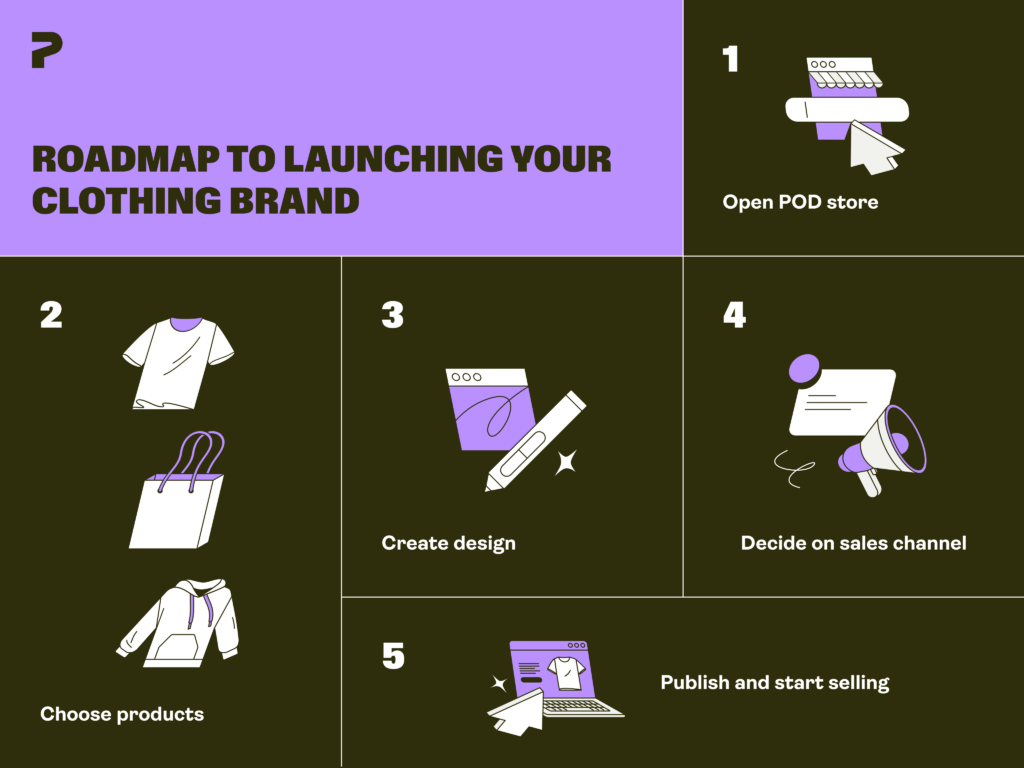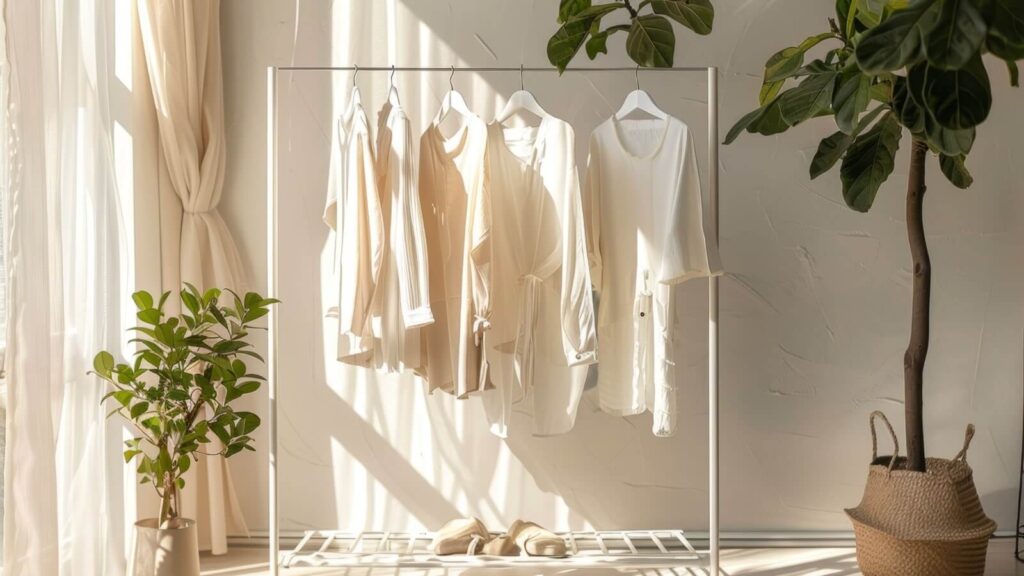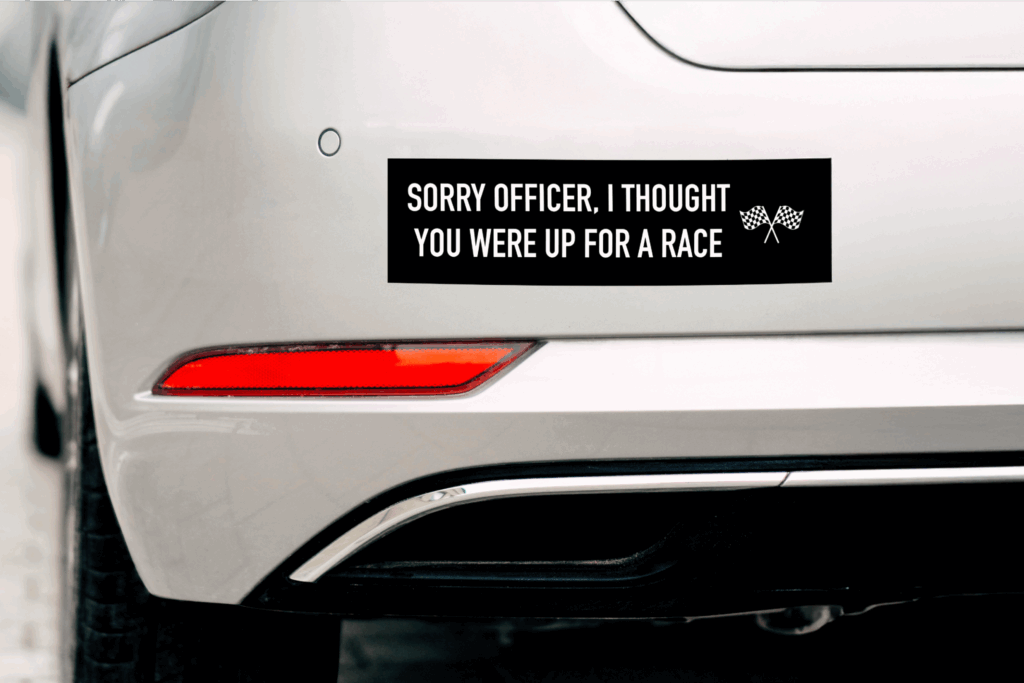Your business, your way – sell with Printify
You don’t need a fashion degree or a massive budget to launch your own clothing brand. With the right tools and a clear plan, anyone can build a clothing business from the ground up – no warehouse or retail store required.
We’ll break down how to start a clothing brand step by step – from picking a business model and designing your first pieces to launching smart marketing campaigns and reaching your customers.
This post may contain affiliate links, which means we may earn a commission if you make a purchase through those links. This comes at no additional cost to you.
Use Printify’s free product designs
Key takeaways
- There’s no one-size-fits-all approach to how to start a clothing company – POD and wholesale offer different levels of cost, risk, and control.
- Strong market research helps you understand your target audience and stand out from other fashion brands.
- A solid business plan keeps your apparel business focused and on track.
- Your designs shape your clothing line and define how customers perceive your brand.
- Ordering samples is the easiest way to avoid quality issues before they reach your potential customers.
The ultimate guide: How to start a clothing brand in 7 steps

Maybe it’s an idea you’ve been sketching in your head for years. Or maybe you’ve just realized there’s a gap in the market you’re ready to fill. Either way, this guide gives you the real stuff.
We’ll cover business models that won’t drain your savings, help you figure out what kind of clothing actually sells, and show you how to build a brand that stands out.
1. Who are you selling to?
Before you pick fabrics, colors, or logos, get to know who you’re selling to. Skip this step, and you’re just guessing – and guessing doesn’t sell shirts.
Start by understanding who your target market actually is.
- Are they into trends or timeless basics?
- Do they care about sustainability or just want the best deal?
- Are they scrolling Instagram for inspo, or hunting for niche pieces no one else has?
This isn’t about building a brand for everyone. It’s about knowing exactly who your stuff is for – and designing around that.
Some things to try:
- Watch what’s trending. Use Google Trends, TikTok, Instagram, Pinterest – wherever your niche hangs out. Track what they wear, what they talk about, and what they ignore.
- Check the competition. Look at other clothing brands in the same space. What are they doing right? What are they missing?
- Spot the gaps. Is there a product they’re not offering? A style that’s outdated? A brand or visual identity that feels forced or fake? That’s your chance to do it better.
You’re not just trying to sell clothes. You’re creating something people actually want to wear. Start there.
2. Select a business model
Before you sketch your first design or choose fabric swatches, decide how your clothing brand will operate. This choice shapes everything – how you make, sell, and scale your brand, whether you’re launching a streetwear label, a luxury line, or a local boutique.
There are two main business models: Print on Demand and the traditional model.
Print on Demand

This is the leanest, fastest way to launch a clothing brand. You create the design – a hoodie, tee, sweatshirt, whatever – and a third-party partner prints and ships it when someone orders. You don’t touch inventory or equipment.
- Pros – Low startup costs, no inventory, simplified logistics
- Cons – Limited control over materials and packaging
POD is ideal for testing ideas, launching limited drops, or starting with minimal risk. You focus on design, marketing, and storytelling – your print provider handles the rest. It’s not just for online stores either – POD works for samples, pop-ups, or local sales too.
Traditional business model
This includes anything where you hold inventory or work directly with suppliers – from bulk-ordering blanks and screen printing locally, to full cut-and-sew manufacturing. It takes more time, money, and planning, but offers more control and higher brand credibility.
- Pros – More control, higher profit potential, stronger brand identity
- Cons – Upfront investment, inventory risk, more moving parts
If you’re building a long-term brand – with signature styles, custom packaging, retail ambitions, or hands-on control over fabric and fit – this model gives you room to grow. It’s how most legacy fashion brands, retail stores, and boutique labels operate.
However, you’ll need to manage sourcing, production, and fulfillment – or partner with pros who can. Either way, this model is for founders ready to craft a standout clothing line from the ground up.
3. Create your brand identity

Your brand isn’t just your logo, font, or packaging. It’s the feeling people get when they see someone wearing your clothing. It’s the story your pieces tell – and how that story makes people want to be part of it.
Whether you’re building a streetwear label, a luxury fashion house, or a niche apparel brand, a clear identity separates you from the sea of generic clothes.
This isn’t about being trendy. It’s about being unforgettable.
Define your brand values and purpose
Start with why. Why does your brand exist? What change are you trying to make in the fashion industry or even the world?
Your values should run through everything – from your designs to your customer service. Sustainability, self-expression, rebellion, craftsmanship, inclusivity – whatever it is, define it early.
Ask yourself:
- What do we stand for?
- What kind of community do we want to create?
- What will our brand never compromise on?
These answers become your compass. They guide your product decisions, marketing voice, and brand story.
What is your brand personality and tone of voice
Your brand should have a distinct voice. Is it bold? Minimalist? Playful? Rebellious?
Your voice will appear in product names, Instagram captions, emails, and even packaging. Get specific. If your brand were a person, how would they speak? What would they care about?
Use this voice consistently across every touchpoint – it builds trust and recognition.
Design your visual identity
This is where your logo, fonts, color palette, and aesthetic come in. These elements should reflect everything you just defined – values, voice, and vibe.
- Choose a logo that’s simple but adaptable – think about how it’ll look on tags, packaging, and social media
- Pick 2-3 brand colors and 1-2 fonts that express your personality
- Create a visual style that matches the lifestyle you’re selling
If you’re not a designer, hire one. Your brand’s look is too important to leave to chance.
Lock in your name and brand story
Your brand name should be:
- Memorable
- Easy to say and spell
- Aligned with your niche and aesthetic
- Available as a domain and social handle
Once you have a name, build your story. Where did the idea come from? Who is it for? What’s the journey behind it?
This story doesn’t have to be long, but it has to be real. People don’t just buy clothes. They buy meaning.
4. Pick and design your products

Your products are your brand in physical form – the fit, the fabric, the feel. This is where your vision becomes something people wear, photograph, and talk about.
If you’re just starting your clothing line, keep it simple. Start with one hero product and do it well.
Start with custom t-shirts
T-shirts are a no-brainer. They’re timeless, affordable to produce, and endlessly customizable. Most successful clothing brands begin with tees – they’re the easiest way to showcase your brand identity, test designs, and build hype.
- Easy to design and update
- High profit potential
- Universally wearable
- Great for building early brand recognition
Once your tees are moving, it’s time to build your product catalog.
Expand strategically
You don’t need a full collection to launch. Just a few well-designed pieces aligned with your brand’s aesthetic and target market will do more than a bloated catalog.
Here are the top categories to consider as you grow:
- Custom hoodies – Excellent for branding, comfort, and seasonal drops
- Custom tank tops – Great for summer collections or gymwear brands
- Custom sweatshirts – Casual, cozy, and always in demand
- Custom jackets – Ideal for premium lines or streetwear-focused brands
- Custom sportswear – Performance-focused gear for fitness or activewear brands
Match your brand’s mission and tone – whether it’s minimalist basics, bold graphics, or technical streetwear.
Don’t overlook athleisure. With the market expected to hit $662.56 billion by 2030, items like leggings, joggers, and performance tops are huge right now – and they’re not going anywhere.
Build collections around themes or seasonal ideas. This will give your product line structure and keep customers coming back for more.
Design with your brand in mind
Your designs should reflect your brand values, your story, and the lifestyle you’re selling. Whether you’re screen printing quotes, creating minimalist logos, or designing full-on prints, every item should feel like it belongs in your world.
- Keep your target customer front and center – What do they actually wear?
- Sketch or build your concepts – Start with pencil and paper if that’s your thing, or jump straight into graphic design tools like Canva, Adobe, or Procreate. Stay inspired by current fashion trends and twist them into something that feels like yours.
- Create mockups that sell – Tools like the Printify Product Creator or PlaceIt let you drop your design onto real product images so you can see exactly how they’ll look when printed.
- Get help if you need it – No shame in outsourcing. If you’re not confident in your fashion design skills, work with a freelancer on Fiverr or Upwork who specializes in fashion design. Provide your ideas or mood boards and let them bring them to life.
- Think beyond the front of a t-shirt – Unique cuts, placement prints, patterns, and unexpected details are what separate generic dropship stores from actual brands. This is your chance to show the world what your style looks like.
- Test color palettes, fabric types, and print placements before committing
You don’t need to be a fashion designer, but you do need taste, clarity, and consistency.
Order samples before selling
This is non-negotiable. Never sell something you haven’t touched yourself.
- Test the fit and sizing
- Check fabric quality and color accuracy
- Inspect print and embroidery quality and durability
- Try on different sizes to understand how they run
Whether you’re using Print on Demand, wholesale blanks, or working with a manufacturer, ordering samples helps you spot issues before customers do – and gives you content for photoshoots, social media, and product listings.
5. Decide where to sell and build your store

Where you sell your clothing shapes how people experience your brand. Whether it’s online, in a retail space, or through pop-ups and stockists – the sales channel you choose affects your margins, visibility, and customer relationships.
There is no one-size-fits-all setup. You need one that fits your clothing business, your target market, and your long-term goals.
Sell through marketplaces or retail platforms
Marketplaces like Etsy, Amazon, and TikTok Shop offer instant access to large audiences. These are great for getting your brand in front of people quickly, but they come with fees, rules, and limited branding control.
- Pros – Built-in traffic, fast setup, low upfront costs
- Cons – Less control over presentation and customer data
This route is fine if you’re just testing products or reaching niche shoppers, but don’t expect it to build deep brand loyalty.
Sell through your own store – online or physical
Having your own store means full creative control, better margins, and a direct relationship with your customers.
Go digital with platforms like Shopify or Wix, or open a brick-and-mortar store, join pop-ups, or partner with boutiques.
- Pros – Full control, better branding, stronger customer loyalty
- Cons – Requires more effort in setup and marketing
This setup works if you want to build your own clothing business that’s recognized for its identity and not just individual products.
Match the channel to your brand
Think about how your customers want to buy from you. Are they shopping online? Browsing fashion markets? Expecting a hands-on retail experience?
Ask yourself:
- Where does my target audience already shop?
- Do I want speed and reach, or control and depth?
- What fits my product, budget, and growth plan?
Start with what makes sense for your brand’s stage – and expand when you’re ready. A clear, consistent buying experience is just as important as the clothes you’re selling.
6. Launch and market your clothing brand
This is where your own clothing line finally hits the real world – and reaches your potential customers. But strong designs and distinctive style aren’t enough. To build a successful business, you need clear positioning, smart marketing strategies, and a brand identity that sticks.
Map out your marketing plan
Start with a clear strategy. Define your goals, budget, and various marketing tactics that align with your clothing business and skill set. You can consider working with a digital marketing agency to plan, execute, and optimize campaigns that support your growth goals.
Some options include:
- Content marketing – Share your process, product stories, and styling tips
- Influencer collaborations – Partner with fashion industry influencers who reach your target audience
- Email campaigns – Build a list and stay top of mind with new drops and exclusive deals
- Referral programs – Reward loyal customers for bringing in new buyers
- Promotions – Use limited-time offers to create urgency and boost conversions
These tools help more than just sales – they build momentum and loyalty over time.
Build your brand’s aesthetic
Everything your fashion brand touches should look and feel like you. From your logo and color palette to your packaging and Instagram grid – consistency builds trust and recognition.
Make sure your:
- Visuals reflect your brand values
- Voice matches your audience
- Customer experience feels intentional, from the landing page to delivery
This is what separates throwaway merch from an actual clothing brand people believe in.
Leverage social media

Use Instagram, TikTok, and Pinterest to connect with your community and show off your products in action. Share behind-the-scenes content, user-generated posts, and on-trend visuals tied to the latest fashion trends.
Great content builds connection. Great timing drives sales.
Stay connected post-launch
Your job doesn’t end after the first drop. Keep building relationships through:
- Email marketing – Share style guides, lookbooks, and new products
- Customer feedback loops – Use insights to refine your clothing designs
- Re-engagement campaigns – Offer incentives for return purchases or reviews
Marketing done right turns a small business into a brand with a following. And that’s what makes you stand out in a crowded market.
7. Analyze, grow, and scale
Launching your own label is just the beginning. A successful brand grows by listening, adapting, and doubling down on what works. Here’s how to move from hustle to strategy.
Track what matters
Use data to guide decisions. Monitor:
- Best-selling clothing items
- Website traffic and conversions
- Email and ad performance
- Repeat purchases
This tells you what’s working – and what needs fixing.
Listen to your customers
How to start a clothing line that’s destined to succeed? Pay attention to consumer preferences. Use reviews, social comments, and support messages to spot trends, improve fit, or kill what’s not selling.
Your target customers will show you the way – you just need to listen.
Scale smart, not wide
Here’s how to make a clothing brand great:
- Expand your clothing line with items that fit your brand’s identity
- Test new drops or limited runs
- Time releases with fashion seasons or trend cycles
No need to overwhelm – focused expansion wins.
Strengthen your systems
As orders grow, tighten your backend:
- Automate fulfillment and email flows
- Use a warehouse or manufacturing facility if scaling volume
- Improve inventory and order tracking
This keeps your small business efficient and profitable.
Stay on brand
Growth shouldn’t dilute your message. Keep your brand image sharp across all channels and marketing campaigns. Consistency builds trust – and a real following.
Join Printify for free and start your own clothing company
How much does it cost to start a clothing line

Costs can vary wildly depending on how you approach your unique brand, from DIY screen printing in your garage to working with high-end fashion retailers. Some routes cost thousands upfront, while others let you start with next to nothing.
Here’s what can add up:
- Hosting and platform subscriptions
- Inventory tools and supply logistics
- Payroll, packaging, utilities
- Marketing (ads, fashion influencers, social media campaigns)
If you’re trying to learn how to start a small clothing business from home with no money, Print on Demand is the leanest model. You design, list, and sell. Production and shipping only happen after someone places an order – no inventory, no bulk buying, no wasted fabric.
Other low-cost options include:
- Dropshipping – You act as the middleman between supplier and buyer. It’s hands-off but gives you less control.
- Wholesale reselling – Buy basic blanks at a wholesale price, then customize or rebrand them. You’ll need to invest upfront, but keep higher margins.
More advanced models like white-label or cut-and-sew operations give you full creative control. But that means securing a manufacturing facility, managing production timelines, and learning how to source fashion fabrics – all before your first sale.
How to start your own clothing brand with no experience using POD

Starting your own clothing line doesn’t require a fashion degree, warehouses full of stock, or a massive upfront investment. With Printify’s POD model, you can launch a fully functional online clothing store from home – no design or tech experience needed.
Sign up for Printify
Create a free Printify account to access over 1,300 customizable products.
Design products
Create your clothing with Printify’s beginner-friendly Product Creator. Upload images, add layered graphics, write text, make all-over prints, or generate artwork with the AI Image Generator – no design experience needed.
Integrate a sales channel
Connect your Printify account to an eCommerce platform like Shopify, Etsy, Wix, or social media giant TikTok to showcase your clothing line and automate order fulfillment. For full control, build a custom site with WordPress and use our API to sync everything seamlessly.
Publish and start selling
Once your designs are ready and your store is live, start selling your clothing items across your chosen platform. Share your products on social media to boost visibility and tap into the pulse of the clothing industry. Track sales, gather feedback, and refine your strategy as you grow.
Why POD works for beginners?
- Zero upfront inventory – only pay when you make a sale
- Flexible product testing without financial risk
- Competitive pricing strategy – set up margins your way
- Scalable from side hustle to full-time brand
- Full creative freedom with minimal setup time
Whether you want to run a sleek fashion business or create a small batch of themed designs for a niche market, POD is the simplest way to start a successful clothing brand without prior experience.
How to start a clothing business: FAQs
Start by defining your brand’s identity and target audience. Then, choose a business model – like Print on Demand or traditional manufacturing. Design your first collection, register your business, and build a marketing strategy that fits your audience.
Whether you launch an online store or sell through retailers, the focus should be on building a brand that people recognize and trust.
If you go with an eCommerce platform like Printify, you can start with little to no upfront investment. There’s no need to hold inventory or buy equipment – you only pay when a product sells. If you choose a traditional clothing business model (like wholesale or private label), expect to invest more upfront for production, storage, and logistics. Your total cost depends on the path you choose.
Not always, but forming an LLC or similar structure can help protect your personal assets and make your clothing business appear more professional. Legal requirements depend on your location and the business model you’re using. Check with local authorities to see what’s needed for your fashion business.
Yes – but only when run like real businesses. A successful brand needs solid designs, clear positioning, smart pricing, and consistent marketing. Start small, test your clothing items, and reinvest profits to scale. Brands that understand their target audience and offer a clear value usually find their niche.
First, determine your target market and the aesthetic of your clothing designs. Then, develop a clothing line business plan and set goals. Next, choose and register a clothing brand name, create a collection, find a manufacturer, and develop a marketing and sales strategy. It may sound like many steps, but if you choose Print on Demand, things will move much faster.
Starting a clothing line with Print on Demand requires little to no upfront investment. You don’t need to buy inventory or equipment – you pay only after someone buys from your online store.
For traditional methods like wholesale or white-label manufacturing, you’ll need more funding for production, storage, and logistics. Your startup costs depend entirely on your business model.
In most cases, yes. You’ll likely need a business license to run an online clothing store, and regulations vary by country and region. Research your local eCommerce laws to stay compliant. Even small businesses need to handle the legal side early.
You need a business model (like POD or wholesale), a design idea, a clothing business plan, and access to tools for product creation and sales. If you’re using POD, all you really need is a computer, an internet connection, design assets, and a small marketing budget to start your clothing brand from home.
How to create a clothing brand: Conclusion
With the right business structure and a clear plan, starting your own clothing brand is more achievable than ever. Print on Demand cuts out upfront costs, so you can focus on design, storytelling, and growing your clothing business.
Use social media to build a strong online presence, connect with your target audience, and test what clicks with potential customers. Whether you’re launching a lean clothing line or scaling a full fashion business, POD gives you the freedom to start small and grow fast – without giving up control.












